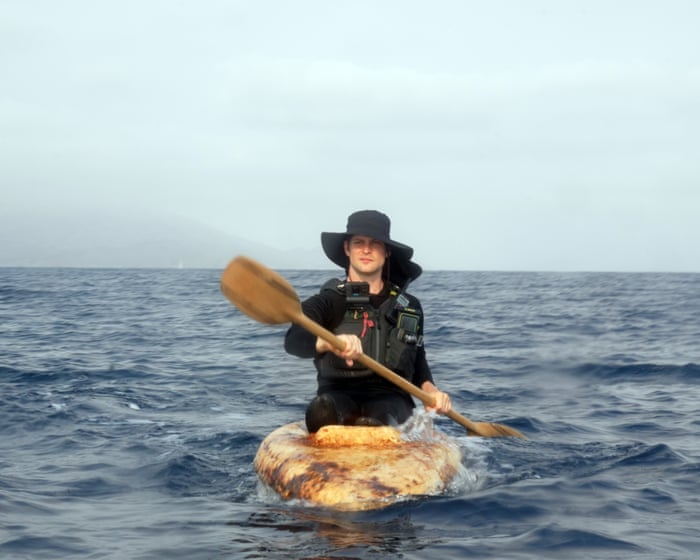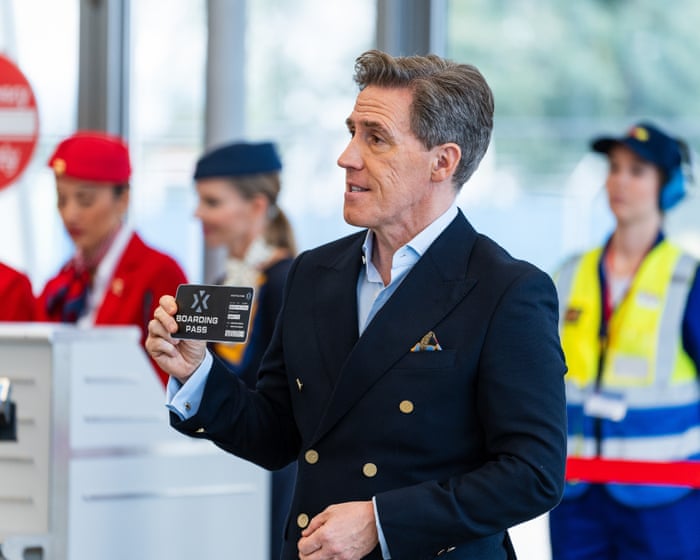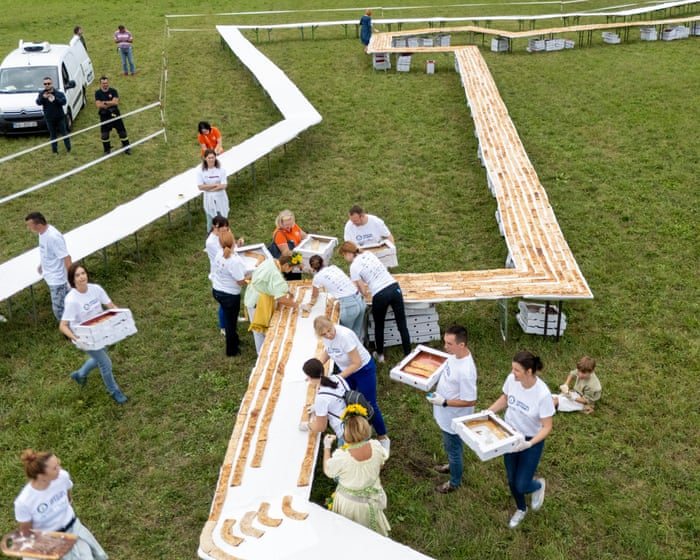On a clear, calm morning in early August, Sam Shoemaker launched his kayak into the waters off Catalina Island and started paddling. His goal was to cross the open ocean to San Pedro, just south of Los Angeles—a distance of about 26.4 miles.
But Shoemaker’s kayak was far from ordinary. Brownish-yellow and bumpy in texture, it wasn’t built—it was grown, entirely from mushrooms. If he succeeded, his journey would become the world’s longest open-water crossing in a kayak made from this unusual material.
Equipped with a phone, GoPro camera, walkie-talkie, and a compass attached to his life vest, Shoemaker set off just before 6 a.m. to avoid the worst of the predicted swells. Three hours in, after powering through nine miles with no land in sight, he began to feel seasick.
Suddenly, he heard a large animal break the surface. To his left, a fin whale flashed its shimmering tail and then swam slowly behind him. For the next three miles, the 50-foot creature followed him, giving Shoemaker the strength to complete his maiden voyage.
“It was like a psychedelic experience,” he said of the 12-hour crossing.
When he finally stumbled ashore with his mushroom kayak still in one piece, the artist and mycologist was greeted by friends and family. They all hoped the journey would spark curiosity about this unconventional fungal material, which Shoemaker and others believe is a more eco-friendly alternative to the plastics commonly used in boats and water sports.
From Gallery Walls to the Open Sea
Shoemaker began his career as an artist, creating sculptures with cultivated mushrooms. After earning an MFA from Yale in 2020 and returning to Los Angeles, he exhibited artwork that showcased mushrooms growing out of handcrafted ceramic and blown glass vessels.
His interests soon expanded beyond gallery walls. Shoemaker is now part of a small community of scientists and artists exploring the potential of fungal innovation as a sustainable material for products like kayaks, buoys, and surfboards.
Their focus is on mycelium—the network of threads that supports the growth of fungi and mushrooms. Though it usually works underground or within a substrate, mycelium is a vital connective tissue in nature. In water-based applications, mycelium materials are known as AquaFung, a term coined by Shoemaker’s mentor, Phil Ross.
Ross is an artist and co-founder of MycoWorks, a biotech company that engineers mycelium-based materials, including a mushroom “leather” used in furniture, handbags, and biomedical equipment. After co-founding MycoWorks, Ross also established an open-source mycology research lab at Stanford called Open Fung.
Ross argues that AquaFung shares many appealing qualities with plastic—like being lightweight and buoyant—but without the environmental harm. “People hate seeing Styrofoam and plastic washing up on shore,” says Ross. “AquaFung is biodegradable. It behaves a lot like the material everyone dislikes, but it’s sustainable.”
Shoemaker started working on his first mycelium boat in 2024, using wild Ganoderma polychromum mycelium harvested near his Los Angeles studio. He repurposed an old fishing kayak as a fiberglass mold and grew the mycelium network inside it, supported by over 300 pounds of inoculated hemp substrate. After cultivating the mycelium for nearly four weeks, Shoemaker carefully…The resulting kayak composite structure was carefully dried using fans over several months. Once dried, the mycelium becomes a strong, water-resistant material. It feels rough and durable to the touch, similar to cork, and its color and texture vary naturally—a reflection of the mushroom’s wild origins.
Confident in his prototype, Shoemaker began looking for support. In December 2023, he met Patrick Reed, lead curator of the Pasadena-based arts organization Fulcrum Arts, through mutual friends. After visiting Shoemaker’s studio, Reed was deeply impressed by the artist’s work, describing their conversation as “incredibly exciting and stimulating.” The project aligned with Fulcrum Arts’ mission to support artists working at the intersection of art and science for social change, and the two began an official collaboration in early 2024.
Shoemaker completed his second mushroom kayak in June. Grown from the same wild Ganoderma polychromum mycelium, the kayak was cultivated on over 520 pounds of a hemp-based substrate packed into a new fiberglass mold. The boat grew over six weeks and then took another three months to dry. Weighing 107 pounds, the new kayak is three feet shorter but has 50% more volume for better buoyancy and stability. It also includes a keel to improve tracking and rigidity.
The community of AquaFung enthusiasts—including mycologists, artists, fishermen, farmers, and hobbyists—is growing but still young. Shoemaker’s boat is only the second mushroom kayak ever tested on water, following Katy Ayers, who holds the Guinness World Record for growing and testing the world’s longest fungal mycelium boat on a Nebraska lake in 2019.
“A lot of people really didn’t think it was possible,” says Ayers, who was inspired by a documentary called Super Fungi. “I reached out to companies that produce biomaterials, and their spokespeople weren’t confident it would work. But I was confident and naive enough to try it and figure out the shortcomings.”
Ayers and Shoemaker credit mycology pioneers like Ross for making the technology more accessible. Mushroom-based materials are gradually entering the mainstream: in 2021, Stella McCartney made headlines by launching the world’s first garments made from lab-grown mushroom leather, developed in consultation with Ross.
Ross calls Shoemaker’s project “remarkable” and hopes it encourages scientific institutions to take this work more seriously. “[Sam] did it before Stanford and Caltech, right in his backyard. This whole field is led by designers and artists—not because they’re the best scientists, but because they see the future before everyone else.”
Still, Shoemaker is cautious about claiming that mushrooms will revolutionize the industry anytime soon. He notes that it took a year’s worth of time and resources to produce just one kayak, which remains slower and heavier than a store-bought ocean kayak.
“People talk about mushrooms as a utopian solution to plastic problems, but this isn’t a silver bullet for making boats easier to produce,” he says. “I’m pleased with how far this project has come, but there’s a long way to go.”
For now, Shoemaker plans to continue collaborating with artists, mycologists, and hobbyists, and will make his open-source compendium—over 70 pages of research, methods, and diagrams—available to the public. A full exhibition of his materials and kayak will be held at Fulcrum Arts’ space in Pasadena in October.”There’s probably some 19-year-old out there thinking, ‘I could do that,’ and they absolutely can,” says Shoemaker. “The best compliment they could give me is to go build a better boat and attempt an even more ambitious crossing than mine.”
Following Shoemaker’s success, Ayers also feels hopeful about a future shaped by fungi. “I’ve been waiting years for someone else to take on this challenge. When my boat set sail, my first thought was, ‘Please, someone try to break this record—it would give me a reason to try again,'” she says. “If we keep inspiring each other and creating better things, who knows? Maybe we’ll see a floating colony of mushroom houses one day.”
Frequently Asked Questions
Of course Here is a list of FAQs about boats made from mushrooms designed to be clear and conversational
General Beginner Questions
Q Wait a boat made from mushrooms Is that even possible
A Yes Its not made from the mushrooms you eat but from the root structure called mycelium This network is grown into a shape and then dried creating a strong waterresistant and buoyant material
Q What exactly is mycelium
A Mycelium is the hidden rootlike part of a fungus Think of it as the wood wide web underground Its a natural binder that can be trained to grow around other materials like agricultural waste to form solid shapes
Q Why would anyone make a boat out of mushrooms
A Primarily for sustainability Unlike fiberglass or plastic boats a mycelium boat is completely biodegradable has a very low carbon footprint to produce and uses waste products as its main ingredients
Q Is a mushroom boat strong enough Wont it just get soggy and sink
A Once the mycelium is fully grown and heatdried it becomes inert and waterresistant Its then sealed with a natural biobased resin to make it fully waterproof and durable
Q Has this actually been done before
A Yes There are successful prototypes A famous example is the Mycelium Canoe project which proved the concept works for a small functional watercraft
Benefits The Future Impact
Q How can this change the future of boating
A It could revolutionize it by offering a truly ecofriendly alternative It moves boat building away from plastics and toxic resins towards a circular compostable model drastically reducing the environmental impact of the industry
Q What are the biggest environmental benefits
A The main benefits are being fully biodegradable using renewable and waste materials and producing almost no carbon emissions during the growth manufacturing process compared to energyintensive traditional methods
Q Could this be used for something bigger like a ship
A In theory yes but its a huge engineering challenge Current research is focused on smaller crafts and using mycelium composites for nonstructural parts like insulation or interior




